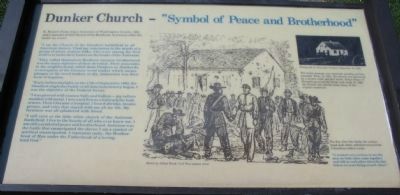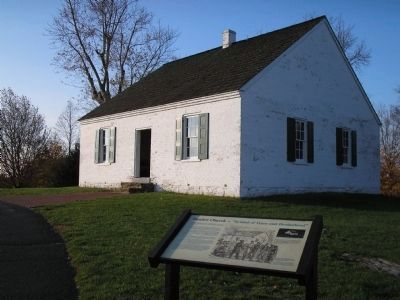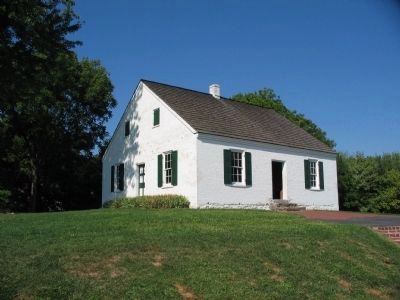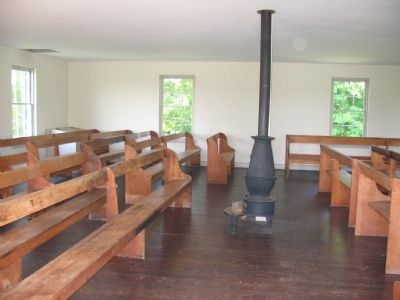Near Sharpsburg in Washington County, Maryland — The American Northeast (Mid-Atlantic)
Dunker Church - "Symbol of Peace and Brotherhood"
Inscription.
E. Russel Hicks was a historian of Washington County, Md., and a member of the Church of the Brethren. A century after the battle he wrote:
"I am the Church of the bloodiest battlefield in all American history. I had my conception in the minds of a group of pious, zealous folks, who were among the first settlers to make their homes on the banks of the Antietam.
"They called themselves Brethren because brotherhood was the main objective of their devotion. Their associates in the neighborhood called them Dunkers or Dunkards, a corruption of the German word tunker which means plunger or the word tunken, to dip. Immersion was their form of baptism.
"Early before daylight, on the 17th of September 1862, the bloodiest single day battle of all American history began. I was the objective of the Federal forces.
"I was pierced with cannon balls and bullets - my rafters studded with metal. I was used first as a bulwark for both armies. Then I became a hospital. I heard shrieks, moans, groans, and cries that stayed with me all my life. My furniture was all splattered with blood.
"I still exist as the little white church of the Antietam Battlefield. I live in the hearts of all who ever knew me. I am still a symbol of peace and brotherhood. Antietam was the battle that emancipated the slaves; I am a symbol of spiritual emancipation. I represent unity, the Brotherhood of Man under the Fatherhood of a loving, kind God."
The day after the battle the armies faced each other, and there was a truce. A Southern soldier wrote:
"It seemed very curious to see the men on both sides come together and talk to each other when the day before we were firing at each other."
Topics. This historical marker is listed in these topic lists: Churches & Religion • War, US Civil. A significant historical date for this entry is September 17, 1862.
Location. This marker has been replaced by another marker nearby. 39° 28.53′ N, 77° 44.803′ W. Marker is near Sharpsburg, Maryland, in Washington County. Marker is at the intersection of Dunker Church Road / Old Hagerstown Pike and Smoketown Road, on the right when traveling south on Dunker Church Road / Old Hagerstown Pike. Located at stop one of the driving tour of Antietam Battlefield. Touch for map. Marker is in this post office area: Sharpsburg MD 21782, United States of America. Touch for directions.
Other nearby markers. At least 8 other markers are within walking distance of this location. Beacon of Peace (here, next to this marker); Destroy the Rebel Army (here, next to this marker); a different marker also named "Destroy the Rebel Army" (here, next to this marker); Jackson's Command (within shouting distance of this marker); Twelfth Army Corps (within shouting distance of this marker); Second Army Corps (within shouting distance of this marker); a different marker also named Twelfth Army Corps (within shouting distance of this marker); 5th, 7th and 66th Ohio Infantry Monument (within shouting distance of this marker). Touch for a list and map of all markers in Sharpsburg.
More about this marker. In the center is a sketch by Alfred Waud, Civil War combat artist depicting the solders mingling and tending the casualties during the truce. On the upper right a photograph by Alexander Gardner, September 19, 1863 is captioned, The battle damage was repaired, worship services resumed. Then, in 1921, the church was destroyed by a severe wind and hail storm. Elmer Boyer of Sharpsburg saved the bricks and wood. In 1962 the church was rebuilt using many of the original materials.
Regarding Dunker Church - "Symbol of Peace and Brotherhood". This marker was replaced by another named Beacon of Peace (see nearby markers).
Related markers. Click here for a list of markers that are related to this marker. Virtual Tour of Markers near Dunker Church,
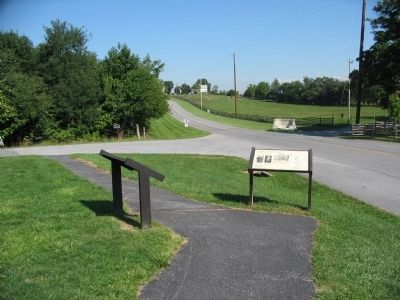
Photographed By Craig Swain, September 17, 2007
3. Tour Stop One - the Dunker Church
On the left is the Dunker Church interpretive marker. Facing the camera is the "Destroy the Rebel Army" interpretive marker. The 59th New York Infantry monument is opposite the church in the distance. Note the fold of the terrain in the background. This section of ground was contested throughout the morning of the battle.
Also see . . . Dunker Church. National Park Service page detailing the history of the church. (Submitted on March 16, 2008, by Craig Swain of Leesburg, Virginia.)
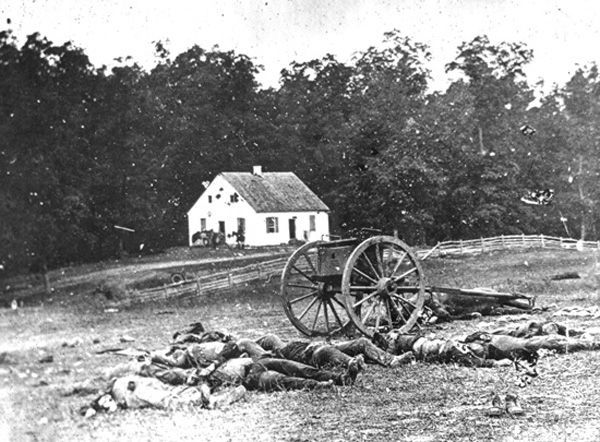
Library of Congress
4. The Gardner Photograph
One of the most recognized photographs from the war. The photo is often titled "Wrecked Battery at the Dunker Church." The dead are likely members of S.D. Lee's artillery battalion, which served guns on the ground to the east of the church during the battle.
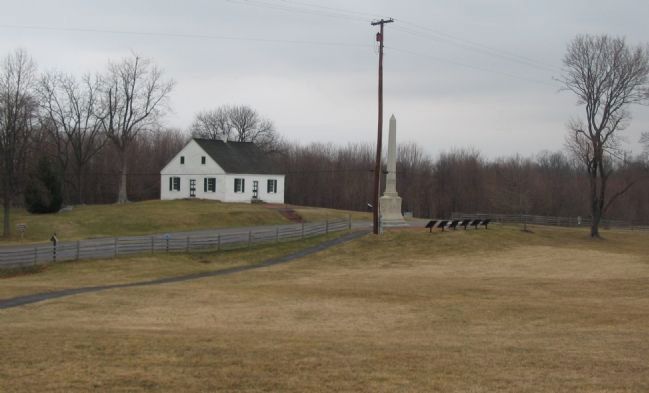
Photographed By Craig Swain, February 9, 2008
5. Similar View as the Gardner Photo Today
The Dunker Church Road crosses the Old Hagerstown Pike road bed between the Church and the Visitors Center. The spot where the wrecked battery stood is near the artillery display just north of the Visitors Center.
Credits. This page was last revised on September 29, 2017. It was originally submitted on March 16, 2008, by Craig Swain of Leesburg, Virginia. This page has been viewed 2,479 times since then and 24 times this year. Photos: 1. submitted on March 16, 2008, by Craig Swain of Leesburg, Virginia. 2. submitted on February 1, 2009, by Bill Coughlin of Woodland Park, New Jersey. 3, 4, 5, 6, 7. submitted on March 16, 2008, by Craig Swain of Leesburg, Virginia.
